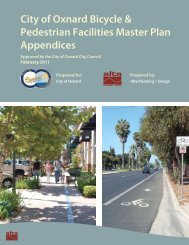View File - Development Services - City of Oxnard
View File - Development Services - City of Oxnard
View File - Development Services - City of Oxnard
You also want an ePaper? Increase the reach of your titles
YUMPU automatically turns print PDFs into web optimized ePapers that Google loves.
WATER RESOURCES TECHNICAL REPORT6.2 ResultsThe simulation results for the end <strong>of</strong> the calibration period, the Base Case, and the Phase 1and Phase 2 scenarios are provided below.6.2.1 End <strong>of</strong> Calibration PeriodThe simulated groundwater elevations at the end <strong>of</strong> the model calibration period, 2000, areprovided in Figure 6-6 and 6-7 for the UAS and LAS, respectively. Overall, the third quarter2000 simulated groundwater elevations are similar to actual fall 2002 data shown inFigures 2-18 and 2-19 for the UAS and LAS, respectively. Variations between these data setsoccur and are due to several factors including: limited number <strong>of</strong> available water levelcontrol points, hand contouring limitations for the 2002 data, and the drier years betweenfrom 2000 and 2002. The third quarter 2000 simulated results indicate the following:• Water levels are 15 to 30 feet above sea level in the UAS along the <strong>Oxnard</strong> Plain coastlineand increase robustly landward to near between 50 to 100 feet above sea level in thecentral to northeastern portion <strong>of</strong> the Forebay area, which is where the UWCDspreading grounds are located.• Water levels are at about sea level in the LAS along the northern <strong>Oxnard</strong> Plain coastline,remain at about sea level landward across most <strong>of</strong> the northern <strong>Oxnard</strong> Plain, and thenincrease to above sea level in the Forebay area.• Water levels are roughly 20 to 30 feet below sea level along the southern <strong>Oxnard</strong> Plaincoastline and decrease landward to a low <strong>of</strong> approximately 70 feet below sea level.6.2.2 Base Case and Phase 1 ScenariosThe simulated third quarter 2020 groundwater elevations for the Base Case and Phase 1scenarios, and the first/third average quarter 2020 water level differences, or changes,between the Base Case and each <strong>of</strong> the Phase 1 scenarios are provided in the followingfigures:• Base Case: Figures 6-8 and 6-9, UAS and LAS, respectively• Scenario 1a: Figures 6-10 and 6-11, UAS and LAS, respectively• Scenario 1b: Figures 6-12 and 6-13, UAS and LAS, respectively• Scenario 1c: Figures 6-14 and 6-15, UAS and LAS, respectivelyHydrographs for the historical and simulated groundwater elevations for each <strong>of</strong> the keyevaluation wells (Figure 6-2) are provided in Figure 6-16 for the Base Case and each <strong>of</strong> thePhase 1 scenarios. The hydrographs are grouped into three areas, one area for each <strong>of</strong> thethree pages <strong>of</strong> hydrographs:• <strong>Oxnard</strong> Forebay Area (page 1 <strong>of</strong> 3)• Northern <strong>Oxnard</strong> Plain Area (page 2 <strong>of</strong> 3)• Southern <strong>Oxnard</strong> Plain Area (page 3 <strong>of</strong> 3)Base CaseThe Base Case resulted in third quarter 2020 groundwater elevations that are lower than thethird quarter 2000 results. This is, in part, because the cumulative from average precipitationW112003002SCO LW1458.DOC/ 033390002 84
















